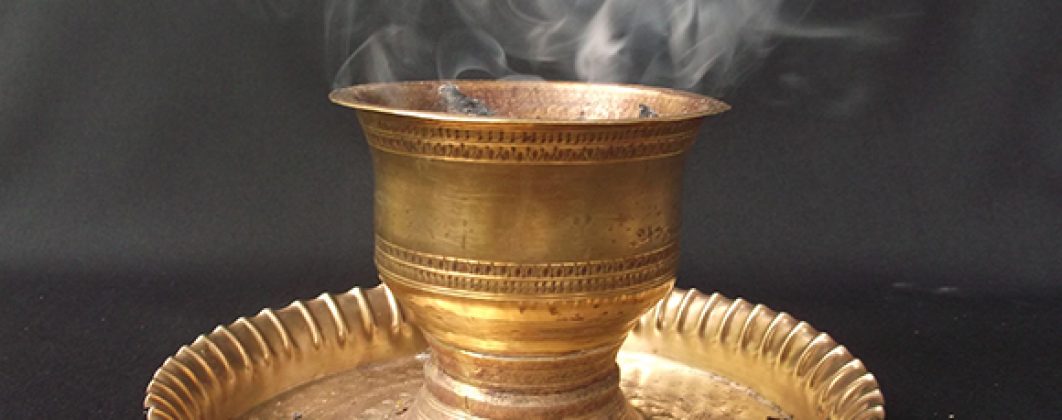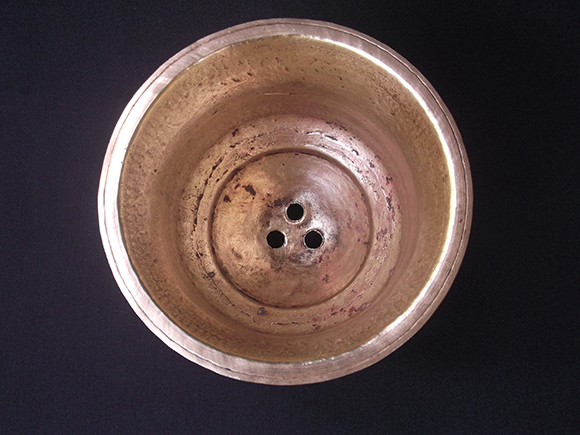

Do you know how ladies used to dry their hair after a head bath in those good old days when electric hair driers were not available? Yes! They had a traditional style of drying the hair with perfumed hot air. Sounds romantic and feels cosy doesn’t it? In the old days, when modern gadgets had not yet invaded the lives of humans, drying wet hair after the bath was a cosmetic ritual. Ladies used Sambrani dhoop, the incense smoke that is generated by burning sambrani powder on the charcoal fire for the purpose. The sambrani powder has an inherent sweet aroma and the smoke that comes out of burning charcoal is warm. Thus, the hair is pampered with hot and sweet scented smoke. The perfumed warm smoke can penetrate into the deep spaces inside tresses from the roots to the ends. For this purpose, the craftsmen of those days designed brass pots that are used to hold burning charcoal with necessary ventilation for oxygen supply required for the burning process. Here is one such antique beautifully designed sambrani burning incense pot made out of brass.





Design of the Sambrani Incense Pot

The pot is made up of two parts joined together. There is a cup to hold the charcoal fire and below the cup is the hollow base that serves as an air gap to supply the oxygen that fuels the fire. The height of the air gap base is 1.5 inches and the height of the charcoal cup is 2.5 inches. The bottom of the charcoal cup has three holes that supply air to the burning charcoal and also serve as drain holes to discharge the charcoal ash. This pot is meant to be kept on a plate for practical reasons. It is not possible to hold the hot brass pot with bare hands and hence it is carried by keeping it on a plate.



Traditionally, sambrani pots are kept on a round plate with a rim around it along with the sambrani powder next to the pot for convenience. Sambrani powder, when it touches the fire, gives a spurt of instant thick smoke and subsides very soon. So, one has to sprinkle another dose of the powder into the charcoal to get the next billow of incense smoke. Hence, it is essential that the charcoal pot and the sambrani powder are together at the same place always and the plate serves as the common ground. The plate is also required to hold the ash coming out from the drain holes. There are intricate designs on the surface of the charcoal pot. There are circular lines designed on the base of the pot. The residue of the burnt sambrani settles on the surface of the charcoal fire which hampers the burning of the charcoal. Hence, it is necessary to fan the fire periodically or reshuffle the charcoal pieces to keep the charcoal fire live.

What is Sambrani?
Sambrani is a term used by traditional medical science Ayurveda for the yellow resin, a gum like substance that comes from perfumed sap of Sal tree. The sap is extracted from the tree by making an incision in the bark of the tree. This herbal resin is then collected and processed in the form of minute granules that are pressed hard to form crystals or bars of sambrani. It is also called as Jhuna.

The botanical name for sambrani is Benzoin resin. It is produced out of the bark of tree species like Genus Styrax. The main component in the resin is Benzoic acid, generally called Benzoin resin.
Benzoin resin is mainly produced by the countries Cambodia, Thailand, Vietnam, Laos, and Sumatra since Styrax species of trees are grown in these countries. Benzoin gum is also used in the orthodox churches of Russia as church incense. In Arab countries of Middle East and in India, Benzoin is burnt over charcoal fire as incense. It is also used in Japan and China in the manufacture of incense sticks.
How is Sambrani Used?
Sambrani is used for multiple purposes like drying the hair of ladies and children, in the temple poojas as incense, as a germicide, as a mosquito repellent, as a sweet fragrance, to create divine atmosphere etc. It is also used as a perfume in the perfume industry, to manufacture incense sticks and cones, as a flavouring substance, and in medicines like Tincture of Benzoin.

Traditionally, sambrani is used to dry the hair by holding hair over the sambrani pot and letting the smoke in. If the hair is really long and thick, another person or a family member could assist by holding the hair over the smoke for effective drying. In instances where there is no one to assist, the ladies devised a method to effectively spread the smoke in the hair and evenly dry it out. This was done by placing a straw basket over the sambrani pot and then holding the hair over the straw basket. This served two purposes. One, it evenly distributed the smoke from the gaps in the straw basket. Two, it reduced dependency and risk of hair burning due to contact with the charcoal.

Since thousands of years, Indian temples have been using incense. It also used in Buddhist and Hindu temple for religious ceremonies as a purifier of atmosphere near the temple areas. It is also used in the pooja rooms in private houses and in domestic shrines during pooja to bring in a meditative ambiance to the religious ceremony. It is also believed that the smoke generated by sambrani wards off evil spirits and cleanses the air. That is one of the reasons why it is mainly used in temples, churches, and in religious ceremonies.
The Medicinal Benefits of Sambrani
The smoky aroma that is generated by roasting the sambrani powder on burning charcoal is therapeutic, antibacterial, and curative. It helps in enhancing sensorial perception and mental clarity. According to Ayurveda and spiritual concepts, it induces serenity, calms the nervous system, revokes negative thoughts, and fosters a quiet mental state. It helps in spiritual practices by enhancing the consciousness and inner awareness.
The amazing uplifting aroma of sambrani is conducive to create soothing ambiance and calm serenity.
Sambrani Oil
Sambrani oil is extracted from exotic resins and several other elements obtained from tropical forests like wood, roots, bark of Genus Styrax species of trees. The oil is extracted by the traditional distillation process using earthen pots. In India, sambrani oil is prepared in the state of Madhya Pradesh. This oil is used in perfumery industry, manufacture of incense, and for medical purpose.
I had sourced this sambrani incense brass pot approximately 35 years ago from an antique dealer in Chennai, Tamil Nadu. We have actively been using the same in our house ever since for pooja, religious ceremonies, and of course drying the hair. If you haven’t experienced using sambrani first-hand, I encourage you to do so. It is soothing, has a great fragrance, and is beneficial. If you are unable to source a brass pot for the purpose, you could go for a much more economical and convenient earthen pot with a similar design and ventilation outlets which are widely available across the country.

Copyright © 2021 YK Antiques Home Museum
5 Responses
Dhanyawaad
Namaskaramandi,can you pls guide me where to buy this brass incense sambrani holder..i want to use it for my new born baby..
Thank you for visiting our website and writing to us, Shweta gaaru. The one that we have in our collection is an antique which I acquired long back. If you are looking for an antique sambrani holder, we will spread the word in our network and see if we can find one. It isn’t something that’s easily available.
For your immediate use, you may consider using a clay sambrani incense holder. The ones made with clay do not transmit heat and are considerably safer to handle for you and your baby.
Hope this helps. Will share any leads as and when we find something relevant. Take care.
Nice item..please do let me know if its available online for buying. Thank you.
Thank you for writing to us. All antiques shared on our blog/social media are part of a private collection on display at our home museum.